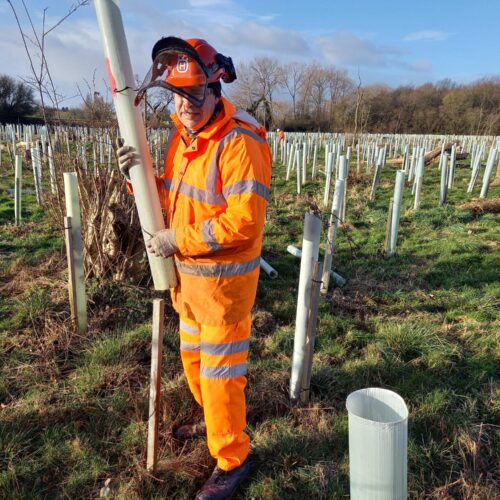Whilst developers are busy building new homes for people, there can often be loss of habitat for protected species who inhabit the area. One of our clients, Redrow Homes, recognises this and takes measures to compensate for any habitat loss. Working together we ensure that birds, reptiles, and great crested newts, among other wildlife, continue to have a suitable place to live both during and after the houses are built.
We are currently working on an offsite compensation project with Redrow Homes where we are transforming former agricultural land into an acidic grassland with many enhanced habitat features. The acidic grassland will compensate for the loss of habitat at the nearby residential development site.
The compensation site is located around 10 miles from the development site in Nethermayne, Essex, and is a large area, covering around 27 ha. We have been working with a local farmer to carry out grassland preparation works including mowing, herbicide treatment, and ploughing. We are now gearing up for the next stage which will include soil preparation and seeding with acidic grassland species to suit the soil conditions found across the site. We also installed over 6km of stock fencing and field gates across the site which will contain grazing animals in the future.
We have carried out enhancement works including installation of bird and owl boxes, and are soon to excavate and plant a number of wildlife ponds to encourage newts, birds, and invertebrates to feed and breed. We will also create a large hibernaculum made up of natural site-derived materials for wildlife to bask and hibernate.
This follows on from work that we did last year, where we created a receptor site adjacent to Redrow Homes’ development site in Nethermayne. The great crested newts and reptiles that had been trapped on the development site were moved to it. As a result, we are happy to report that great crested newts have started to breed in the ponds that we created there. It is satisfying to see ecological mitigation practices proving to be successful.
Leigh Johnson, Senior Development Manager at Redrow Homes (Eastern) said, “One of Redrow’s placemaking principles is the creation of new or enhancement of existing wildlife habitats. We truly believe that when delivering homes it is important that wildlife is taken into consideration and suitable mitigation measures are put in place. At Nethermayne, where we are delivering up to 725 homes in the coming years, we have worked closely with Thomson Ecology on a number of initiatives to ensure that the local wildlife has a suitable environment during and post construction.”











